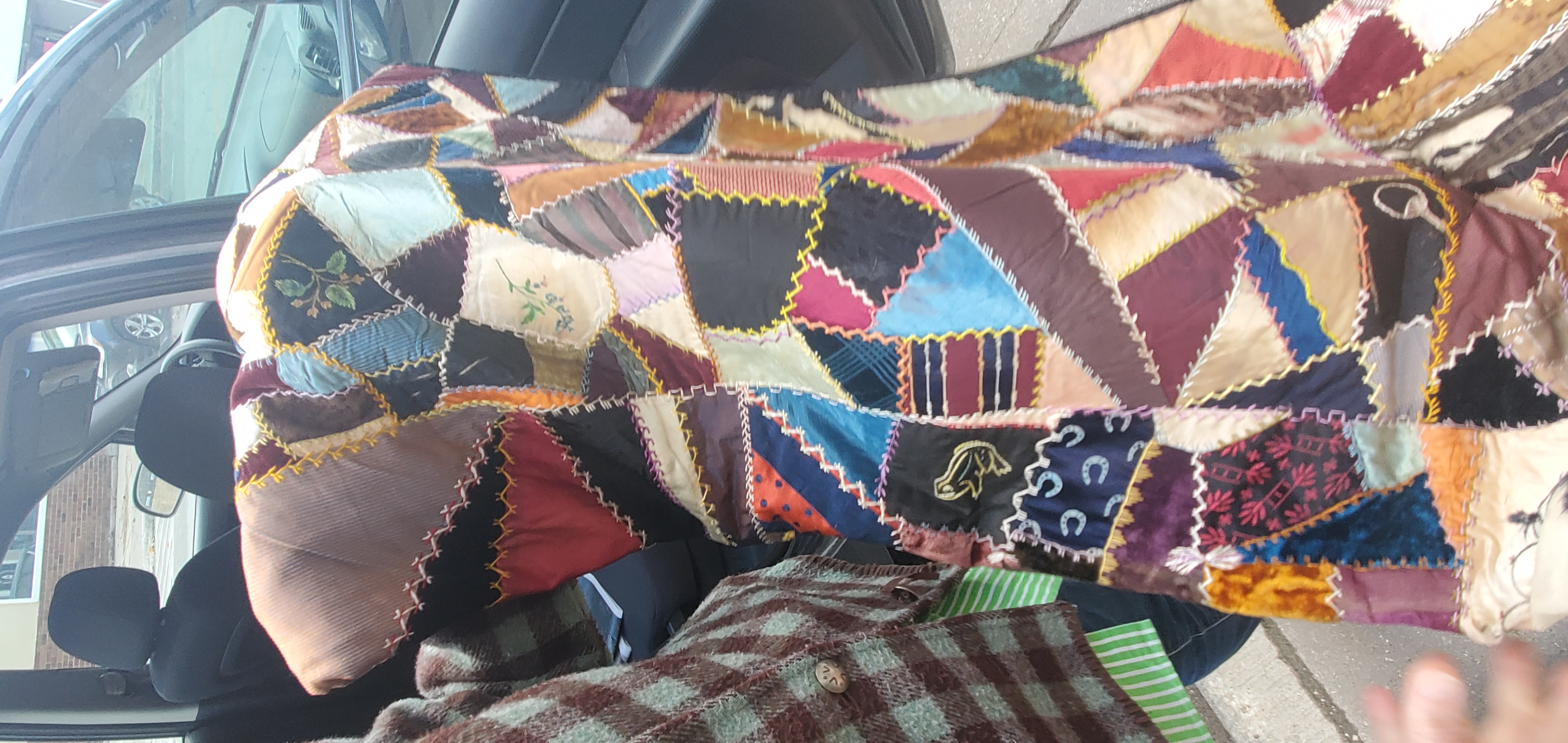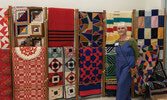By Mel Luymes
Karen Poce delicately opens up a large quilt made of dozens of fabric pieces, including upholstery and hand painted details, pointing out the delicate embroidery. This is called a crazy quilt, without any set pattern, and every last stitch was done by hand. Whose hands, however, we will never know. Karen rescued this quilt from a landfill. It could have been a family heirloom brought here from another country, but its history is now gone; we can only imagine the creativity and dedication of a woman (presumably) who would have spent several months, and maybe years, between all her other chores to stitch this beautiful quilt together.
 This is just one of dozens of quilts that Karen has rescued and now includes in her traveling “Quilt Crusader Trunk Show” for local audiences, in which she also shares her window into the world of second hand and vintage clothing in the global economy. She sheds light on how our clothes are made and where they go after we donate our used clothing, how that has changed over time and the impact of synthetic fabrics and “fast fashion” on the world. When it comes to the new trend of “up-cycling” clothes, Karen points out that is exactly what women were doing throughout history with their quilts.
This is just one of dozens of quilts that Karen has rescued and now includes in her traveling “Quilt Crusader Trunk Show” for local audiences, in which she also shares her window into the world of second hand and vintage clothing in the global economy. She sheds light on how our clothes are made and where they go after we donate our used clothing, how that has changed over time and the impact of synthetic fabrics and “fast fashion” on the world. When it comes to the new trend of “up-cycling” clothes, Karen points out that is exactly what women were doing throughout history with their quilts.
A quilt has three layers, and the front patterned layer is arranged from scraps of fabric, often from old clothing, and stitched together first. Then a cotton batting layer is added between a back layer, with small stitches going through all three layers traversing the length and width of the quilt to give its textured look. Often, this last step was done with a small group of women working on the same piece together, talking and spreading the news of the day as they stitched by hand.
While sewing machines and longarm quilting machines allow for quilts to be made more quickly these days, some are still making quilts in the old tradition, including our Amish neighbours. To this day, it remains a labour of love; the number of hours put into a hand-stitched quilt can never be fully compensated. As such, quilts are often gifted or put to auction or raffle to raise money for a community cause, such as the Amish School Auction.
When Karen sees quilts, she connects with the people who made them; she sees their creativity, their precision and their dedication. And on a rare occasion, she might even see a pinprick of blood from a slip of the needle. Quilts are more than just a blanket to keep us warm, more than something beautiful to decorate a wall, they often have a story and mark a special occasion or gift in a family, passed down as heirlooms between generations.
Karen was steeped in her own family’s traditions, growing up in an Italian family in the West end of Toronto. Her grandmother, mother and aunts crocheted baby sets and sold them during the Depression. She developed a love for textiles that carried her throughout her career picking clothing for vintage shops, to the Royal Ontario Museum and to her work today as a “Quilt Crusader.”
In the early ‘90s, Karen replied to a job ad and became a part-time “picker” for Union Made, a vintage wholesaler. She would visit Toronto-area factories as they were processing clothing that had been discarded from second hand shops and either baling them for export to the developing world, making them into rags or sending them to landfill. She would sort through it all looking for quality vintage clothing that would be purchased from the factory (by weight) and would be resold at some of the trendy shops in Kensington Market.
Not only did she develop a keen eye for fabrics and quality, but Karen also found a love for quilts, which she would rescue from landfill by buying from the factories herself. She restored and re-sold quilts downtown at the St. Lawrence Market. She loved knowing that a restored quilt could be enjoyed for another hundred years.
At that time, she also worked at the Royal Ontario Museum (ROM) and eventually became a full-time Preparator there, handling and mounting artifacts, preparing various galleries, cases and mannequins to display textiles. She met her now husband, Chris Palmer, who also worked there and together they bought a rural property near Chesley in the mid-90s where they would spend their weekends and holidays. In 2010, when both retired from the ROM, the couple moved permanently to Chesley.
Karen continues her passion for quality, textiles, fashion and history as a quilt crusader, buying, restoring and selling old quilts at antique shows in Aberfoyle, Keady, Elora and Toronto. She has a Trunk Show of 25 rescued quilts that she shows to various quilting guild audiences.
She also works with people to document and preserve their family quilts for the future. One of her first customers was Penny Crawford, also of Chesley. When her mother, Lila (Baker Cain) McKay, passed away in 2017, Penny and her sister, Debbie Smith, inherited a legacy of several quilts from their mother, grandmothers, great-grandmother and a great aunt, on both sides of the family. Karen worked to document the history and to photograph each piece, storing them in acid-free paper in museum-quality boxes that would protect the quilts from pests, moisture and light.
One of Penny and Debbie’s favourite quilts that is now stored safely away is a Canada Day quilt that their mother made, and it still is shown at Fall Fairs from time to time. With the emblem of every province of the country, in red and white, her mother Lila was quite proud of it. But when a blue chalk marker that she used to mark her top stitches wouldn’t come clean, she was devastated. Washing only made it worse, but time and some sunlight have made the blue stains barely visible today.

Another quilt in their family history is a crazy quilt that was made from upholstery samples by their paternal great-grandmother for her grandfather. Their grandfather had a tremendous fall from a grain elevator, and they don’t remember much of him working on the farm, but of him smoking his pipe by the woodstove near this quilt. Their aunt thought it was quite ugly, which Penny admits it was, and it smelled strongly of smoke. When they donated it to the Grey Roots Museum, the staff stored it in the freezer for some time to take the smoke smell out of the fabric (which it did!) and it is now part of their collection.
While it would have been quite difficult to sew upholstery and it is rare to see such a piece, quilts could be made of any sort of scrap fabric. Karen recalls seeing a quilt that a mother had made as a gift for her daughter, quilted out of all the flannel nightgowns that she had as a child. Historically, it is common to see old feed sacks incorporated into quilts. Especially in the Depression era, flour companies would put colourful prints into their fabric sacks, that women would use to make clothing, dolls or quilts.
Karen herself quilts with a group of local women about twice a month and while Penny laughs that she can’t quilt well enough to do it, her sister Debbie followed in their mother’s footsteps and is an excellent seamstress and quilter. Debbie was a long-time member of a large quilting guild in Newmarket, and when she moved to Mount Forest two years ago, she joined the Four Corners Quilter’s Club. Established in the late ‘90s, the guild is about 50 members from the area that meet in-person and by zoom to learn more about stitching and quilting, see what projects others are working on, and make quilts for community donations. Debbie is now the president, alongside Sue Ewles.
Debbie also teaches quilting and sewing to a next generation at Creekbank Sewing Centre in Conn. While she sees that the average age of women in quilting guilds is going up, she is hopeful that new people will take up the hobby like the generations before them.
If you have an old quilt that you don’t quite know what to do with, feel free to reach out to Karen to discuss. You can find her at www.quiltcrusader.com or at one of the local markets. If you’d like to learn from Debbie, you can contact Creekbank Sewing Centre by calling (519) 323-2693 to sign up for a class. And for the quilters or soon-to-be quilters out there, Karen urges people to sign and date their work so that they can be recognized as the quilt is hopefully passed down through the generations. ◊


